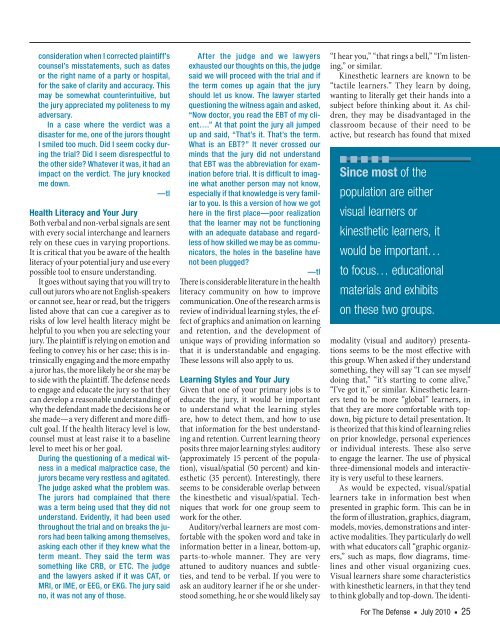For The Defense, July 2010 - DRI Today
For The Defense, July 2010 - DRI Today
For The Defense, July 2010 - DRI Today
- No tags were found...
Create successful ePaper yourself
Turn your PDF publications into a flip-book with our unique Google optimized e-Paper software.
consideration when I corrected plaintiff’scounsel’s misstatements, such as datesor the right name of a party or hospital,for the sake of clarity and accuracy. Thismay be somewhat counterintuitive, butthe jury appreciated my politeness to myadversary.In a case where the verdict was adisaster for me, one of the jurors thoughtI smiled too much. Did I seem cocky duringthe trial? Did I seem disrespectful tothe other side? Whatever it was, it had animpact on the verdict. <strong>The</strong> jury knockedme down.—tlHealth Literacy and Your JuryBoth verbal and non- verbal signals are sentwith every social interchange and learnersrely on these cues in varying proportions.It is critical that you be aware of the healthliteracy of your potential jury and use everypossible tool to ensure understanding.It goes without saying that you will try tocull out jurors who are not English- speakersor cannot see, hear or read, but the triggerslisted above that can cue a caregiver as torisks of low level health literacy might behelpful to you when you are selecting yourjury. <strong>The</strong> plaintiff is relying on emotion andfeeling to convey his or her case; this is intrinsicallyengaging and the more empathya juror has, the more likely he or she may beto side with the plaintiff. <strong>The</strong> defense needsto engage and educate the jury so that theycan develop a reasonable understanding ofwhy the defendant made the decisions he orshe made—a very different and more difficultgoal. If the health literacy level is low,counsel must at least raise it to a baselinelevel to meet his or her goal.During the questioning of a medical witnessin a medical malpractice case, thejurors became very restless and agitated.<strong>The</strong> judge asked what the problem was.<strong>The</strong> jurors had complained that therewas a term being used that they did notunderstand. Evidently, it had been usedthroughout the trial and on breaks the jurorshad been talking among themselves,asking each other if they knew what theterm meant. <strong>The</strong>y said the term wassomething like CRB, or ETC. <strong>The</strong> judgeand the lawyers asked if it was CAT, orMRI, or IME, or EEG, or EKG. <strong>The</strong> jury saidno, it was not any of those.After the judge and we lawyersexhausted our thoughts on this, the judgesaid we will proceed with the trial and ifthe term comes up again that the juryshould let us know. <strong>The</strong> lawyer startedquestioning the witness again and asked,“Now doctor, you read the EBT of my client….”At that point the jury all jumpedup and said, “That’s it. That’s the term.What is an EBT?” It never crossed ourminds that the jury did not understandthat EBT was the abbreviation for examinationbefore trial. It is difficult to imaginewhat another person may not know,especially if that knowledge is very familiarto you. Is this a version of how we gothere in the first place—poor realizationthat the learner may not be functioningwith an adequate database and regardlessof how skilled we may be as communicators,the holes in the baseline havenot been plugged?—tl<strong>The</strong>re is considerable literature in the healthliteracy community on how to improvecommunication. One of the research arms isreview of individual learning styles, the effectof graphics and animation on learningand retention, and the development ofunique ways of providing information sothat it is understandable and engaging.<strong>The</strong>se lessons will also apply to us.Learning Styles and Your JuryGiven that one of your primary jobs is toeducate the jury, it would be importantto understand what the learning stylesare, how to detect them, and how to usethat information for the best understandingand retention. Current learning theoryposits three major learning styles: auditory(approximately 15 percent of the population),visual/spatial (50 percent) and kinesthetic(35 percent). Interestingly, thereseems to be considerable overlap betweenthe kinesthetic and visual/spatial. Techniquesthat work for one group seem towork for the other.Auditory/verbal learners are most comfortablewith the spoken word and take ininformation better in a linear, bottom- up,parts-to-whole manner. <strong>The</strong>y are veryattuned to auditory nuances and subtleties,and tend to be verbal. If you were toask an auditory learner if he or she understoodsomething, he or she would likely say“I hear you,” “that rings a bell,” “I’m listening,”or similar.Kinesthetic learners are known to be“tactile learners.” <strong>The</strong>y learn by doing,wanting to literally get their hands into asubject before thinking about it. As children,they may be disadvantaged in theclassroom because of their need to beactive, but research has found that mixedSince most of thepopulation are eithervisual learners orkinesthetic learners, itwould be important…to focus… educationalmaterials and exhibitson these two groups.modality (visual and auditory) presentationsseems to be the most effective withthis group. When asked if they understandsomething, they will say “I can see myselfdoing that,” “it’s starting to come alive,”“I’ve got it,” or similar. Kinesthetic learnerstend to be more “global” learners, inthat they are more comfortable with topdown,big picture to detail presentation. Itis theorized that this kind of learning relieson prior knowledge, personal experiencesor individual interests. <strong>The</strong>se also serveto engage the learner. <strong>The</strong> use of physicalthree- dimensional models and interactivityis very useful to these learners.As would be expected, visual/spatiallearners take in information best whenpresented in graphic form. This can be inthe form of illustration, graphics, diagram,models, movies, demonstrations and interactivemodalities. <strong>The</strong>y particularly do wellwith what educators call “graphic organizers,”such as maps, flow diagrams, timelinesand other visual organizing cues.Visual learners share some characteristicswith kinesthetic learners, in that they tendto think globally and top-down. <strong>The</strong> identi-<strong>For</strong> <strong>The</strong> <strong>Defense</strong> n <strong>July</strong> <strong>2010</strong> n 25
















